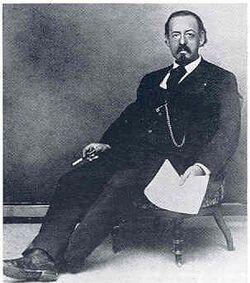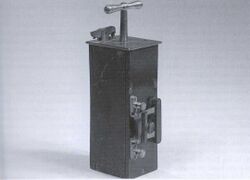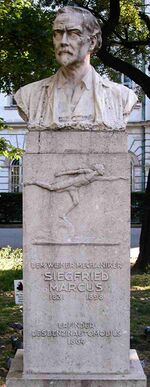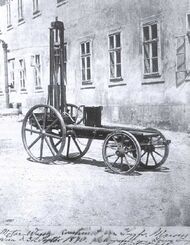Biography:Siegfried Marcus
Siegfried Samuel Marcus (German: [ˈziːkfʁiːt ˈmaʁkʊs]; 18 September 1831 – 1 July 1898) was a German inventor. Marcus was born of Jewish descent in Malchin, in the Grand Duchy of Mecklenburg-Schwerin. He made several petrol-powered vehicles, the first one in 1864, while living in Vienna, Austria.[1]
Life
Marcus was born in Malchin, in the Grand Duchy of Mecklenburg-Schwerin into a Jewish family. Today Malchin is part of Germany. He began work at age 12 as an apprentice mechanic. At 17 he joined Siemens and Halske, an engineering company that built telegraph lines. He moved to Vienna, the capital of the Austrian Empire, in 1852, working first as a technician in the Physical Institute of the Medical School. He then worked as an assistant to Professor Carl Ludwig, a physiologist. In 1860 Marcus opened his own workshop which made mechanical and electrical equipment.[1] The first was located at Mariahilferstrasse 107 and the second at Mondscheingasse 4.
His chief improvements include telegraph relay system and ignition devices such as the "Wiener Zünder", a blasting machine. Marcus was buried at the Protestant Cemetery at Hütteldorf, Vienna. Later, his remains were transferred to an "Honorary Tomb" of Vienna's Central Cemetery.
Nazi rewrite
Because of Marcus' Jewish ancestry, his name and all memorabilia, particularly in Austria, vanished under the Nazis. In 1937 the Austrian Harand Movement Against Racial Hatred had issued a series of stamps featuring prominent Jews, including Marcus, who had contributed to mankind in response to the Ewiger Jude (eternal Jew) exhibition by Julius Streicher in Munich. Marcus was credited as having invented the petrol driven motor car.[2] With the German occupation of Austria in March 1938, the memorial in front of the Vienna Technical University was removed. After World War II, the monument was rebuilt and his car, which had been hidden, was returned to display.
Marcus was removed from German encyclopedias as the inventor of the modern car, under a directive from the German Ministry for Propaganda during World War II. His name was replaced with the names of Daimler and Benz. The directive (in German) read as follows:
Reichsministerium für Volksaufklärung und Propaganda
Geschäftszeichen. S 8100/4.7.4.0/7 1
Berlin W8, den 4. Juli 1940
Wilhelmplatz 8-9An die Direktion der Daimler-Benz-A.G. Stuttgart-Untertürkheim
Betrifft: Eigentlichen Erfinder des Automobils
Auf Ihr Schreiben vom 30. Mai 1940 Dr.Wo/Fa.Das Bibliographische Institut und der Verlag F.A. Brockhaus sind darauf hingewiesen worden, dass in Meyers Konversations Lexikon und im Großen Brockhaus künftig nicht Siegfried Marcus, sondern die beiden deutschen Ingenieure Gottlieb Daimler und Carl Benz als Schöpfer des modernen Kraftwagens zu bezeichnen sind.
In English this would be
Reich Ministry of Public Enlightenment and Propaganda
Reference number S 8100 / 4.7.4.0 / 7 1
Berlin W8, 4 July 1940
Wilhelmsplatz 8-9To the Directorate of Daimler-Benz A.G. Stuttgart-Untertürkheim
Subject: True inventor of the automobile
Referring to your letter of 30 May 1940 Dr.Wo / Fa.The Bibliographical Institute and the publisher F. A. Brockhaus have been notified that in the future, [the encyclopedias] Meyers Konversations Lexikon and the Große Brockhaus are to refer to the two German engineers Gottlieb Daimler and Carl Benz as the creators of the modern automobile, not to Siegfried Marcus
.
Current Austrian thinking is that Marcus' first car ran in the late 1880s.[3] However, early publications suggest that he may have had a petrol powered vehicle running earlier than 1870.[4] The deliberate destruction of evidence of Marcus' inventions by the Nazi regime has left these dates open to debate and speculation.[5] Britannica cites 1864 for Marcus' first car with a 10-year gap to the second, which is consistent with other sources.[6]
Marcus' cars
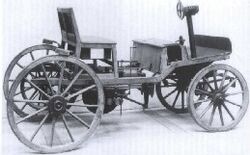
Based on the information from existing sources, Marcus' first machine was built on a simple handcart in 1870.[7] but had to be started by lifting the drive wheels off the ground and spinning them. The internal combustion engine was designed for liquid combustibles and made him the first to propel a vehicle by means of petrol. Marcus was not satisfied with this cart and dismantled it.[6]
In 1883 a patent for a low-voltage ignition magneto was given to Marcus in Germany and a new petrol engine built.[8]
This design was used for all further engines, including that of the only existing Marcus car from 1888–1889. It was this ignition, in conjunction with the "rotating brush carburettor", that made the engine's design very innovative. By 1886 the German navy was using the engine in its torpedo boats.[9]
In 1887, Marcus started a co-operation with the Moravian company Märky, Bromovsky & Schulz. They offered two stroke and — after the fall of the Otto-Patent in 1886 — four stroke engines of the Marcus type.
In 1888-1889 Märky, Bromovsky & Schulz built the car which can still be seen in Vienna's Technical Museum. This car made Marcus well-known all over the world.[10] The car was named a Historic Mechanical Engineering Landmark by the American Society of Mechanical Engineers.[1]
John Nixon of the London Times in 1938 considered Marcus' development of the motor car to have been experimental, as opposed to Benz who took the concept from experimental to production. Nixon described Marcus' cars as impractical.[11] 12 years later, in 1950, the Times described the car at the Vienna Technical Museum as being built in 1875 and the first petrol-powered road vehicle. A description of its first journey of 7.5 miles from Vienna to Klosterneuberg was included in the article.[12]
Patents
Marcus was the holder of 131 patents in 16 countries. He never applied for a patent for the motorcar and, of course, he never held one. Nevertheless, he was the first to use petrol to propel a vehicle, in the simple handcart of 1864, but it is uncertain whether the extant Marcus car ran before 1890.[citation needed]
Some examples of his patents:
- 33258, 10 September 1861, Improvements to relay magnets[13]
- 2058, 6 July 1872, Device for mixing of fuel with air[14]
- 286030, 2 October 1883, Improved gas engine[15]
- 306339, 7 October 1884, Electrical igniting device for gas engines[16]
In conjunction with Captain E von Wohlgemuth of the Imperial German Navy, Marcus invented an electrical ignition of ships cannons. The advantages of the system were that it allowed for the simultaneous firing of the cannons, or selection of a particular firing pattern, and the ability to fire them from the ship's bridge.[17]
Sources
- Bürbaumer, Ursula (1998) (in German). Das erste Auto der Welt?. Vienna: Erasmus.
- Hardenberg, Horst (2000) (in German). Siegfried Marcus, Mythos und Wirklichkeit. aus der Wissenschaftlichen * Schriftenreihe des DaimlerChrysler Konzernarchivs. Bielefeld: Delius & Klasing. Awarded as the June 2001 book of the month by the Austrian Academy of Science.
- Böttcher, Norbert (2005) (in German). Siegfried Marcus. Teetz: Hentrich & Hentrich.
- Bürbaumer, Ursula; Steinböck, Johannes; Hardenberg, Horst; Schaukal, Gerhard; Mergl, Ladislav (2000). Grössing, Helmuth. ed (in German). Autos-Fahrer – Konstrukteure. Vienna: Erasmus.
- Bürbaumer, Ursula (2003), "Siegfried Marcus in Wien" (in German), Dissertation Database (Austrian Research Centers)
See also
- History of the internal combustion engine
- List of Austrian scientists
References
- ↑ Jump up to: 1.0 1.1 1.2 "Siegfried Marcus Car (ca. 1875)". Landmarks. American Society of Mechanical Engineers. https://www.asme.org/about-asme/who-we-are/engineering-history/landmarks/203-siegfried-marcus-car. Retrieved 2016-09-22. Note: ASME gives an incorrect construction date of 1875.[clarification needed]
- ↑ "Philosemitic Aryans". The Daily Telegraph (London) (25742): p. 14. 30 November 1937.
- ↑ Jump up to: 3.0 3.1 Ebert, Anne-Katrin. "Marcus-Wagen, 1888/1889". Vienna Technical Museum. http://www.technischesmuseum.at/object/marcus-wagen-1888-1889.
- ↑ "Motor Notes. By "Accumulator."". Progress II (5): 20. 1 March 1907. https://paperspast.natlib.govt.nz/periodicals/P19070301.2.15?query=motor. Retrieved 22 September 2016.
- ↑ Kurinsky, Samuel. "Siegfried Marcus An Uncredited Inventive Genius - Fact Paper 32-I". Hebrew History Foundation. http://www.hebrewhistory.info/factpapers/fp032-1_marcus.htm.
- ↑ Jump up to: 6.0 6.1 "Siegfried Marcus | German inventor". Encyclopædia Britannica. https://www.britannica.com/biography/Siegfried-Marcus.
- ↑ handritten notes of Marcus himself on the photo
- ↑ "Ignition". The Record-Union (Sacramento, California): p. 7. 13 December 1884. https://www.newspapers.com/image/156028394/?terms=%22siegfried%2Bmarcus%22%2Bvienna.
- ↑ "Austro-Hungary". The Times (London): p. 5. 16 November 1886. https://www.newspapers.com/search/#query=%22Siegfried+Marcus%22&dr_year=1860-1895.
- ↑ Österreich Lexikon. 2. Vienna. 2004.
- ↑ Nixon, John C. (29 March 1938). "The First Motor Car". The Times (London) (47955): p. 52.
- ↑ "1875 Motor-Car Driven Again". The Times (London) (51667): p. 3. 17 April 1950.
- ↑ Report of the Commissioner of Patents, Volume 1, Published 1863, page 494
- ↑ The London Gazette, Part 3 Publisher T. Neuman, 19 July 1872, page 3270
- ↑ Specifications and Drawings of Patents Relating to Electricity Issued by the U. S., Volume 33, Published 1885
- ↑ Specifications and Drawings of Patents Relating to Electricity Issued by the U. S., Volume 37, Published 1886
- ↑ "Electrical discharge of artillery on board men-of-war". Telegraphic Journal and Electrical Review 16: 442–443. 16 May 1885.
External links
- "Marcus, Siegfried". AEIOU Encyclopedia. http://aeiou.iicm.tugraz.at/aeiou.encyclop.m/m138853.htm;internal&action=_setlanguage.action?LANGUAGE=en.
- "Siegfried Marcus" (in German). Museum Malchin. http://www.museum-malchin.de/siegfried-marcus/.
- Buerbaumer, Ursula (2003). "Siegfried Marcus in Wien. Der Mikrokosmos eines unkonventionellen Mechanikers". Österr. Bibliothekenverbund & Service GmbH. http://media.obvsg.at/DD00039396.
